Amazon ground station for rent - receiving and processing data from satellites
In early December, Amazon announced the deployment of a network of ground stations for receiving and processing information from satellites. Large satellite operators often build and operate their own ground stations to manage their own satellite network. This is a costly event and the costs are very high for the rapidly growing number of owners of cheap cube.
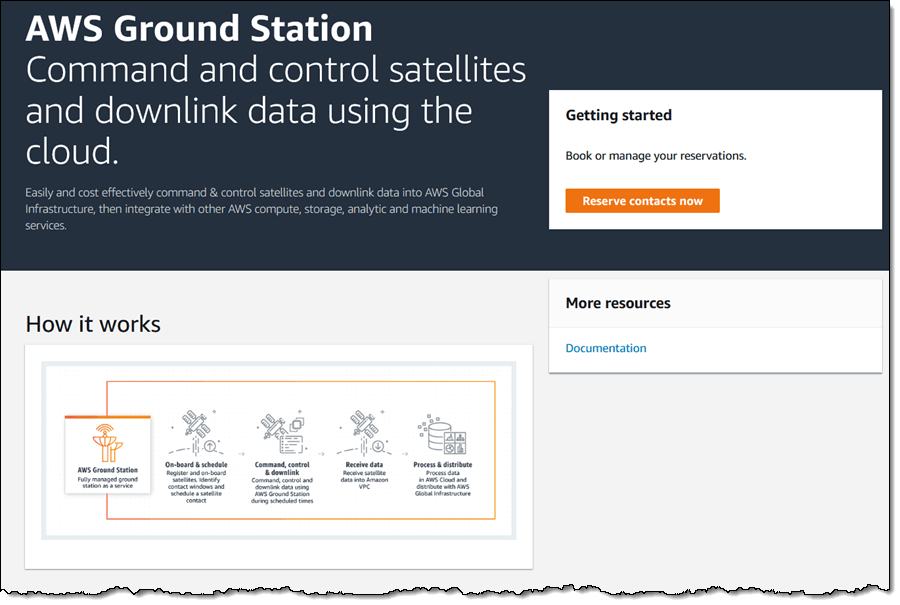
The well-known service Amazon Elastic Compute Cloud (EC2) is known for cost-effective utilization of compute-to-use computing power. AWS Ground Station does the same with the use of ground satellite stations. Instead of building your own ground station or concluding a long-term contract for its lease, it became possible to use the AWS ground station by the minute of need and payment.
Usually, the owner of the Kubsat is limited in access to his own satellite, most often his only ground station contacts the satellite several times a day, but it is now possible to urgently gain access to the ground station to handle a special event observed by the satellite: severe weather disasters, natural disaster or something more positive, for example, a sporting event.
If access to the ground station is necessary to regularly receive data from the satellite or distribute content via satellite, you can reserve the station in advance and pay even less.
Amazon started with a pair of stations in 2018 and plans to deploy 12 stations by mid-2019. Each ground station is associated with a specific AWS region. The analog signal received by the station is converted into a data stream, which is sent to the Amazon EC2 instance, in which the signal is processed into data. Data presented in digital form can be processed, analyzed, stored and transmitted:
Thus, work with a satellite, starting from ground stations and ending with processing, storage, reporting and delivery, can now be performed using a flexible payment infrastructure as you use it.
To use AWS Ground Station , a satellite owner must have a satellite NORAD ID, FCC license information and an AWS account ID.
To get started, open Ground Station Console and click Reserve contacts now.

In the first step, it is necessary to reserve a “contact” - schedule the time when the satellite will be in the optimal position for transmitting data to the selected ground station.

You can filter by status (Available, Scheduled, and Completed) and by time.
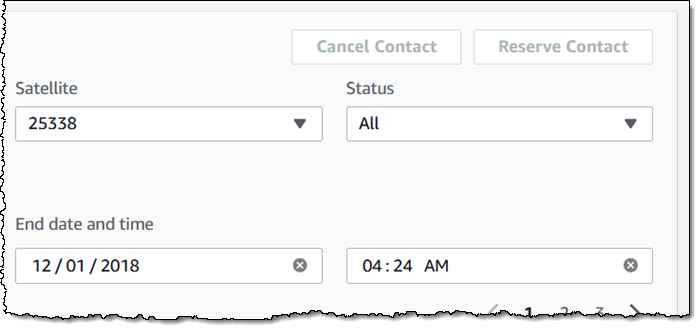
In the contact list, you must select one contact that meets the requirements, and reserve by clicking Reserve Contact.
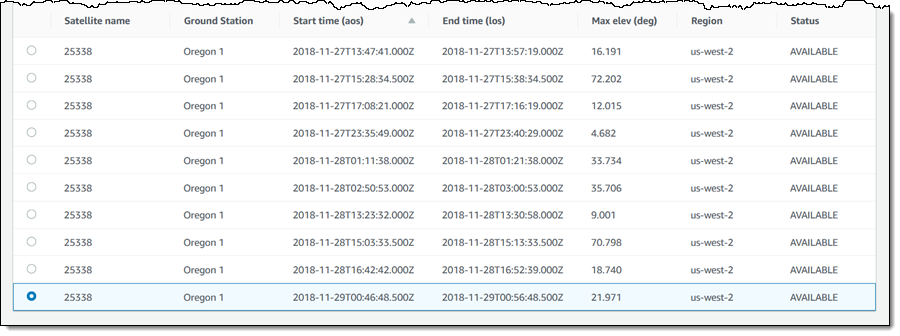
On the next page, you must confirm the contact by pressing Reserve.
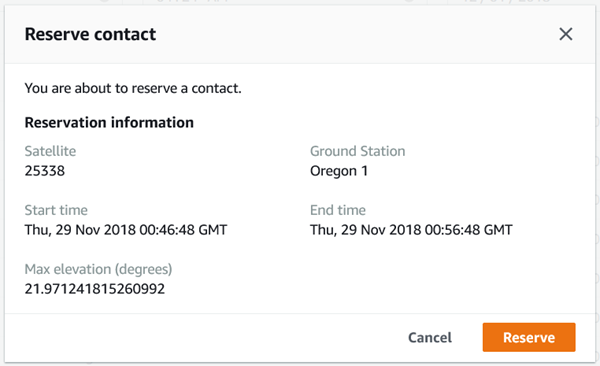
Then you can filter the list of contacts to show all upcoming reservations:
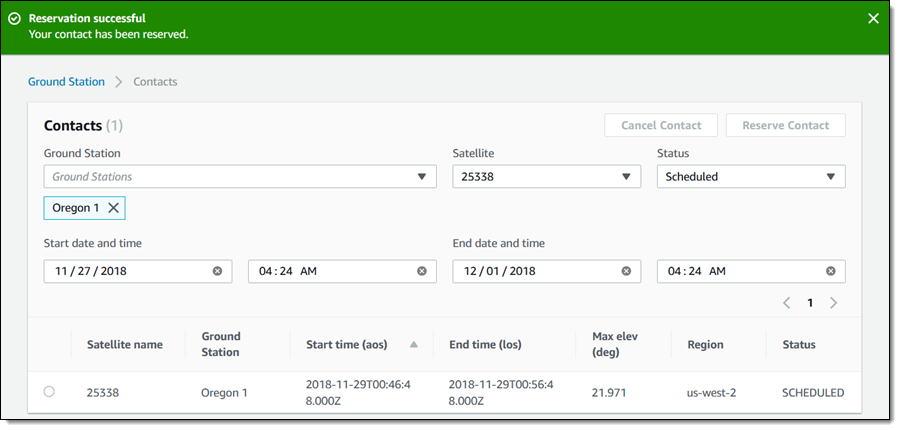
After reserving, you need to make sure that the Amazon EC2 instance is operating in the same region as the station, at least 15 minutes before the reserved contact time. The Amazon EC2 signal processing instance connects to the Elastic Network Interface (ENI), uses DataDefender to control data transfer, and sends data to a software modem, such as qRadio, to digitize the data.
Obviously, Amazon focuses on commercial cubes, whose owners can pay for AWS Ground Station services. Fans, first of all, student teams, still have to rely on their own ground station and the help of the free amateur radio network SatNOGS - a free open source software platform designed to create a network of satellite ground stations. A recent story with a student satellite CubeSail demonstrates the relevance of such networks of ground stations, and Amazon was the first to enter this market. As demand and demand increase, Amazon plans to build additional stations and antennas.

The well-known service Amazon Elastic Compute Cloud (EC2) is known for cost-effective utilization of compute-to-use computing power. AWS Ground Station does the same with the use of ground satellite stations. Instead of building your own ground station or concluding a long-term contract for its lease, it became possible to use the AWS ground station by the minute of need and payment.
Usually, the owner of the Kubsat is limited in access to his own satellite, most often his only ground station contacts the satellite several times a day, but it is now possible to urgently gain access to the ground station to handle a special event observed by the satellite: severe weather disasters, natural disaster or something more positive, for example, a sporting event.
If access to the ground station is necessary to regularly receive data from the satellite or distribute content via satellite, you can reserve the station in advance and pay even less.
Amazon started with a pair of stations in 2018 and plans to deploy 12 stations by mid-2019. Each ground station is associated with a specific AWS region. The analog signal received by the station is converted into a data stream, which is sent to the Amazon EC2 instance, in which the signal is processed into data. Data presented in digital form can be processed, analyzed, stored and transmitted:
- Streaming - Amazon Kinesis Data Streams for capturing, processing, and saving data streams.
- Processing - Amazon Rekognition for image analysis; Amazon SageMaker to create, train, and deploy Machine Learning models.
- Analytics / Reporting - Amazon Redshift for storing processed data; Amazon Athena and Amazon QuickSight for data queries.
- Storage - Amazon Simple Storage Service (S3) for data storage, with Amazon Glacier for data archiving and long-term storage.
Thus, work with a satellite, starting from ground stations and ending with processing, storage, reporting and delivery, can now be performed using a flexible payment infrastructure as you use it.
How to use AWS Ground Station
To use AWS Ground Station , a satellite owner must have a satellite NORAD ID, FCC license information and an AWS account ID.
To get started, open Ground Station Console and click Reserve contacts now.

In the first step, it is necessary to reserve a “contact” - schedule the time when the satellite will be in the optimal position for transmitting data to the selected ground station.

You can filter by status (Available, Scheduled, and Completed) and by time.

In the contact list, you must select one contact that meets the requirements, and reserve by clicking Reserve Contact.

On the next page, you must confirm the contact by pressing Reserve.

Then you can filter the list of contacts to show all upcoming reservations:

After reserving, you need to make sure that the Amazon EC2 instance is operating in the same region as the station, at least 15 minutes before the reserved contact time. The Amazon EC2 signal processing instance connects to the Elastic Network Interface (ENI), uses DataDefender to control data transfer, and sends data to a software modem, such as qRadio, to digitize the data.
Obviously, Amazon focuses on commercial cubes, whose owners can pay for AWS Ground Station services. Fans, first of all, student teams, still have to rely on their own ground station and the help of the free amateur radio network SatNOGS - a free open source software platform designed to create a network of satellite ground stations. A recent story with a student satellite CubeSail demonstrates the relevance of such networks of ground stations, and Amazon was the first to enter this market. As demand and demand increase, Amazon plans to build additional stations and antennas.
